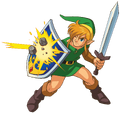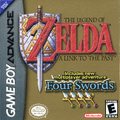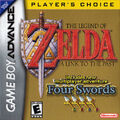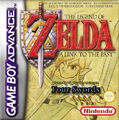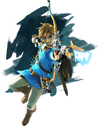PhantomCaleb (talk | contribs) m (→Gallery) |
m (Reverted edits by Hylian King (talk) to last revision by Fizzle) |
||
| Line 72: | Line 72: | ||
<gallery> |
<gallery> |
||
File:ALttPFStitle.png|The title screen |
File:ALttPFStitle.png|The title screen |
||
| − | File:ALttPFSfile. |
+ | File:ALttPFSfile.PNG|The file select screen |
File:ALttPFSgame.png|The game select screen |
File:ALttPFSgame.png|The game select screen |
||
</gallery> |
</gallery> |
||
Revision as of 02:17, 6 February 2013
Template:GameNav
Template:UC
Template:Game
The Legend of Zelda: A Link to the Past & Four Swords for Game Boy Advance is a remake of A Link to the Past coupled with an entirely new game, Four Swords. It was released shortly before The Wind Waker. While A Link to the Past is largely a faithful port of the original, it does include an entirely new dungeon and a new quest as rewards for the player playing through the multiplayer-only Four Swords. Aside from these additions, it includes a number of smaller gameplay and dialogue changes, the latter of which seem designed to better unify the connection this game has in the timeline with Ocarina of Time.
Four Swords as later released as a standalone entry with added single player option and new stages on the Nintendo DSi, known as The Legend of Zelda: Four Swords Anniversary Edition, but the Game Boy Advance version of A Link to the Past has not been released again in any form, nor have any of the changes made been carried over to the Virtual Console release.
A Link to the Past's Differences
Gameplay Changes
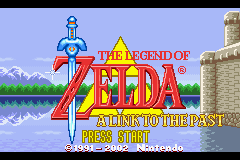
The new title screen
- The File Select screen is entirely new and is displayed before selecting one of the two games. When starting a new game, the original File Select screen is not displayed. When starting a new game, the story of the Imprisoning War and the rest of the prologue is now displayed before the game begins. The player can also skip the Triforce sequence before the title screen appears, which was previously only possible in the PAL version of the game.
- A new dungeon, known as the Palace of the Four Sword, can be found on the eastern side of the Pyramid of Power. While Link can access, he will be stopped by a Pikku and cannot pass unless the player fulfills the requirements of completing the game once and defeating Vaati once in Four Swords on the same save file.
- A new boss in the form of four Dark Links and four powered-up versions of previous bosses that are considerably stronger and require new tactics to defeat appear in the Palace of the Four Sword.
- A new ending and credit sequence after conquering the Palace of the Four Sword, including a new Quest Record that displays how many times Link has used certain items.
- A new quest, known as the Riddle Quest, which is available from a third Lumberjack once the player has obtained ten Medals of Courage in Four Swords.
- A new ability, the Hurricane Spin, obtained after completing the Riddle Quest.
- The flames from the Lamp can now cause minor damage to enemies.
- Pots can now be shattered using the Golden Sword or the Silver Arrows. This new ability is used for puzzles in the Palace of the Four Sword. Signs can also be destroyed with the sword.
- Link can now dive under the water when using Zora's Flippers. This allows him to avoid damage from enemy attacks.
- The Ice Palace dungeon was altered slightly to make the puzzle requiring Link to push a block to a lower floor slightly easier.
- Crows are now more aggressive, but their Dark World counterparts Kyunes are less so.
- Certain stones and skulls will sparkle on the overworld. If Link strikes these with his sword, they will scatter Rupees. Link can continue striking them until they return to normal.
- A new shop appears in the Village of Outcasts that sells Bees, Fairys and Golden Bees.
- A new enemy, the Like Like, was introduced, and appears in the Palace of the Four Sword and in the woods to the east of the Pyramid of Power. They will eat Link's shield much like Pikits, but also run away and fly into the sky to stop him from getting it back. They will also eat the Mirror Shield.
- The shop found to the west of the Pyramid of Power not only sells Red Shields, but also sells Fighter's Shields and, once Link obtains it Turtle Rock, Mirror Shields. This is because Link can now lose his Mirror Shield from Like Likes.
- The cave in the Light World that can be accessed by using the Magic Mirror from outside Turtle Rock no longer contains Goriya, which are normally a Dark World exclusive enemy, and now contains Eyegores.
- When reloading a save file, it is now possible to start from the same location you left the game. This places Link exactly where he left the game on the overworld, or at the start of a dungeon. It is also possible to "Save and Continue" without dying, rather than simply "Save and Quit*.
- Saving and quitting no longer counts as a "game played" on the Quest History, making it a lot easier to get a "perfect" game.
- The R button now performs the actions that the A button would normally perform.
- When Link's Rupees, Arrows or Bombs are full, the color of the number turns yellow to signify this.
- The Chris Houlihan Room is accessible in the GBA version, but Chris Houlihan's name is not mentioned in the game text.
Audio and Visual Changes
- The game has a lighter color palette to compensate for the lack of back light on the Game Boy Advance, giving the game a washed out appearance in screenshots. However, the player can adjust the brightness on a file, and switching to "Dark" sets the colors to the same as the original release. There is also a "Bright" option, which makes things even lighter.
- There is an option to speed up and slow down the text speed.
- The game has a slightly smaller viewing area, sacrificing some height.
- The title screen is altered slightly, particularly the appearance of the Master Sword, and the addition of a "Press Start" prompt.
- The icons that display at the top of the screen have been adjusted to compensate for the smaller screen area. The pause menu has also been adjusted.
- The music and sound effects have been altered slightly due to the sound capabilities of the GBA, resulting in some lower quality samples.
- Link now has a different voice, taken from that of Young Link and will also yell when attacking.
- Enemies and bosses now flash white and shake when struck, rather than flash multiple colors.
- The role of the Witch's Assistant was changed to that of Maple from Oracle of Seasons and Oracle of Ages.
- Faeries are now called Fairys like other games in the series.
- The Good Bee was renamed to the more accurate translation of Golden Bee.
- The Seven Wise Men are referred to as Seven Sages.
- Among other significant dialogue changes to better correct the translation, Link's Uncle does not say "Zelda is your..." when Link receives his sword and shield. This line is however referenced in the Palace of the Four Sword.
- The Pegasus Shoes were renamed to their correct name of Pegasus Boots.
- During the prologue sequence, the blue Soldiers hold spears rather than swords. Originally this was only the case in the Japanese version of the game.
- Pots make the same sound effect for shattering even if they fall down a pit, unlike the original game.
- Ganon's arm when holding his trident has been mirrored vertically.
New Artwork
Aside from the aforementioned changes, new artwork was produced to promote and commemorate the new release. Each piece of artwork was based on those created for the original release, but updated with a slightly more modern anime style. Some pieces, most notably artwork for Agahnim, used new poses.
Gallery
- ALttPFSfile.PNG
The file select screen
New A Link to the Past Artwork
- Linkalttpr.png
Link
- Agahnim.png
Agahnim
- ALttP-FS Link.png
Link in his original artwork's pose
Link using his Fighter's Shield
Link using the Bow
Link performing a Dashing Attack
Link using the Whirling Blade Attack
- Link Zelda ALttP-FS.jpg
Princess Zelda speaking to Link telepathically
The Ball and Chain Trooper guarding Zelda
- Sewer passageway remake.png
Link leading Princess Zelda through the Sewer Passageway
- Link vs. Geldman.png
Link fighting a Geldman
Four Swords Illustrations
- Linkspetoctorok.png
The four Links attacking an Octorok
Box Art
References
| Language | Name | |
|---|---|---|





